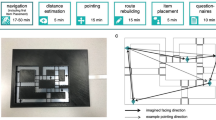Abstract
Accurate and quick navigation poses a major challenge for the visually impaired and those who have been hit by power outages, smoke and fog. SSDs are expected as a technical approach to this problem. The improvement of navigation by SSD and the knowledge of neuroscience and cognitive psychology are not so linked. In this study, we examine sensory information and strategies related to improving navigation by reviewing existing SSDs from the perspective of neuroscience and using the triangle completion task that has been used for a long time in cognitive psychology. From reviewing SSDs, it was found that depth information, direction information, and object information provide the information necessary for constructing spatial representations instead of vision. We found out that a strategy of recalling triangles using Labeled graphs is effective in the long term for improving navigation. Directional information encourages the construction of labeled graphs, and feedback on the direction of the navigation goal makes it accurate via the acquisition of metaknowledge and improvement of subjective scale. Our research would make a great contribution to the development of SSDs for navigation.
Access this chapter
Tax calculation will be finalised at checkout
Purchases are for personal use only
Similar content being viewed by others
References
Bourne, R.R.A., Flaxman, S.R., Braithwaite, T., et al.: Magnitude, temporal trends, and projections of the global prevalence of blindness and distance and near vision impairment: a systematic review and meta-analysis. Lancet Glob. Heal. 5(9), e888–e897 (2017)
Trullier, O., Wiener, S.I., Berthoz, A., Meyer, J.A.: Biologically based artificial navigation systems: review and prospects. Prog. Neurobiol. 51(5), 483–544 (1997)
Franz, M.O., Mallot, H.A.: Biomimetic robot navigation. Rob. Auton. Syst. 30(1), 133–153 (2000)
Eichenbaum, H.: The role of the hippocampus in navigation is memory. J. Neurophysiol. 117(4), 1785–1796 (2017)
Wang, R.F.: Building a cognitive map by assembling multiple path integration systems. Psychon. Bull. Rev. 23(3), 692–702 (2015). https://doi.org/10.3758/s13423-015-0952-y
Chrastil, E.R., Warren, W.H.: From cognitive maps to cognitive graphs. PLoS ONE 9(11), e112544–e112544 (2014)
Ekstrom, A.D., Huffman, D.J., Starrett, M.: Interacting networks of brain regions underlie human spatial navigation: a review and novel synthesis of the literature. J. Neurophysiol. 118(6), 3328–3344 (2017)
Loomis, J.M., Klatzky, R.L., Golledge, R.G., Philbeck, J.W.: Human navigation by path integration. Wayfinding Behav. Cogn. Mapp. Spatial Process. 125–151 (1999)
Segond, H., Weiss, D., Sampaio, E.: Human spatial navigation via a visuo-tactile sensory substitution system. Perception 34(10), 1231–1249 (2005)
Stoll, C., Palluel-Germain, R., Fristot, V., Pellerin, D., Alleysson, D., Graff, C.: Navigating from a depth image converted into sound. Appl. Bionics Biomech. 2015, 1–9 (2015). https://doi.org/10.1155/2015/543492
Chebat, D.R., Maidenbaum, S., Amedi, A.: Navigation using sensory substitution in real and virtual mazes. PLoS ONE 10(6), 1–18 (2015)
Hoffmann, R., Spagnol, S., Kristjánsson, Á., Unnthorsson, R.: Evaluation of an audio-haptic sensory substitution device for enhancing spatial awareness for the visually impaired. Optom. Vis. Sci. 95(9), 757–765 (2018)
Jicol, C., Lloyd-Esenkaya, T., Proulx, M.J., et al.: Efficiency of sensory substitution devices alone and in combination with self-motion for spatial navigation in sighted and visually impaired. Front. Psychol. 11, 1443 (2020)
O’Keefe, J.: Place units in the hippocampus of the freely moving rat. Exp. Neurol. 51(1), 78–109 (1976)
Solstad, T., Boccara, C.N., Kropff, E., et al.: Representation of geometric borders in the entorhinal cortex. Science 322(5909), 1865–1868 (2008)
Kärcher, S.M., Fenzlaff, S., Hartmann, D., et al.: Sensory augmentation for the blind. Front. Hum. Neurosci. 6(MARCH 2012), 1–15 (2012)
Kaspar, K., König, S., Schwandt, J., König, P.: The experience of new sensorimotor contingencies by sensory augmentation. Conscious Cogn. 28(1), 47–63 (2014)
Schumann, F., O’Regan, J.K.: Sensory augmentation: integration of an auditory compass signal into human perception of space. Sci. Rep. 7(January) (2017)
Taube, J.S.: The head direction signal: origins and sensory-motor integration. Annu. Rev. Neurosci. 30(1), 181–207 (2007)
Massiceti, D., Hicks, S.L., van Rheede, J.J.: Stereosonic vision: exploring visual-to-auditory sensory substitution mappings in an immersive virtual reality navigation paradigm
Rolls, E.T.: Spatial view cells and the representation of place in the primate hippocampus. Hippocampus 9(4), 467–480 (1999)
Rolls, E.T., Xiang, J.-Z.: Spatial view cells in the primate hippocampus and memory recall. Rev. Neurosci. 17(1–2), 175–200 (2006). https://doi.org/10.1515/REVNEURO.2006.17.1-2.175
Fujita, N., Klatzky, R.L., Loomis, J.M., Golledge, R.G.: The encoding-error model of pathway completion without vision. Geogr. Anal. 25(4), 295–314 (1993)
Acknowledgement
The authors would like to thank participants for cooperating with experiments. This research was supported by Grants-in-Aid for Scientific Research B (17H01946).
Author information
Authors and Affiliations
Corresponding author
Editor information
Editors and Affiliations
Rights and permissions
Copyright information
© 2021 The Author(s), under exclusive license to Springer Nature Switzerland AG
About this paper
Cite this paper
Akimoto, K., Fukawa, A., Yairi, I.E. (2021). Strategy and Spatial Representations for Improving Navigation Ability Without Vision Using Sensory Substitution Devices. In: Yada, K., et al. Advances in Artificial Intelligence. JSAI 2020. Advances in Intelligent Systems and Computing, vol 1357. Springer, Cham. https://doi.org/10.1007/978-3-030-73113-7_21
Download citation
DOI: https://doi.org/10.1007/978-3-030-73113-7_21
Published:
Publisher Name: Springer, Cham
Print ISBN: 978-3-030-73112-0
Online ISBN: 978-3-030-73113-7
eBook Packages: Intelligent Technologies and RoboticsIntelligent Technologies and Robotics (R0)




